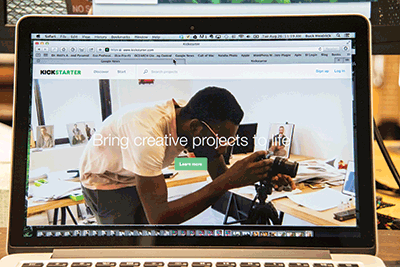Crowdfunding is defined as the practice of funding a project or venture by raising monetary contributions from a large number of people, typically via the Internet. In 2013, according to Forbes, the crowdfunding industry grew to be over $5.1 billion worldwide. Southwest Washington entrepreneurs are increasingly turning to crowdfunding to launch their ideas.
Easier access to money
Crowdfunding is growing in popularity, said Buck Heidrick, a certified business advisor with the Washington Small Business Development Center, partly because startup loans are difficult to obtain from banks.
“There are few banks that do startup loans, and the loans are few and far between,” he said.
Damon Rose, senior vice president and senior credit officer at Pacific Continental Bank, said that crowdfunding may play an important role for businesses that are not quite ready for bank financing. For example, businesses with an idea may seek crowdfunding to help them realize this idea through research and development, whereas a bank will traditionally get involved after the idea has been vetted, tested and proven.
Southwest Washington businesses who have successfully used crowdfunding include Bluer Denim (founded by Jeff Shafer, who also is the founder of Ridgefield-based Agave Denim), OurBar and Doomsday Brewing in Washougal, the Kiggins Theater and manufacturer ProtoPlant Inc. in Vancouver, the Stageworks NW Theater in Longview and WildCraft Studio in White Salmon.
As Shafer pointed out, crowdfunding provides far more than just money. Shafer used Kickstarter to launch Bluer Denim last year, raising more than $44,000. Although he was “glad to get the money,” the publicity, customer base and market research were equally valuable.
“Crowdfunding enables simultaneous product production and market testing,” said Shafer. “The market gives you instantaneous feedback about whether they like your idea or not.”
In addition, Shafer said, crowdfunding platforms such as Kickstarter and Indiegogo are closely followed by magazine editors, innovators and early adopters.
“By virtue of launching on Kickstarter, you get your idea out in front of these types of people, including venture capitalists,” explained Shafer. “Essentially, it’s a PR campaign.”
Heidrick agreed, stating that crowdfunding helps assess feasibility of an idea and “becomes a marketing campaign to create a buzz for your product, and you can’t get that from a bank.”
Keys to success
First and foremost, “you have to come up with a really good offering,” said Shafer. “I’m pretty sure the majority of crowdfunding projects fail, and many don’t even make it through the vetting process.”
This echoes Heidrick’s experience, who said, “In general, what we’re finding is that you have to have a really unique and compelling idea.” This might be a new product or a social spin on a product, such as sustainability or ‘made in America.’
Heidrick said that in 2013, he had several clients who tried crowdsourcing, and only one had been successful.
Bluer Denim, which raised more than twice their goal of $20,000, captured the imagination and emotions of backers with a business model centered around a product that is completely and transparently made in the USA and sold directly to customers at “revolutionary prices.” Additionally, Bluer added the concept of repurposing/recycling denim (for every pair of jeans you purchase, the company will buy back a used pair for $5, sanitize them, and deliver them to someone who really needs them).
Beyond pitching good idea, said Heidrick, make sure your presentation is good; a great video is a compelling element that can powerfully connect with people and make them want to be a part of your venture.
Things to watch out for
Crowdfunding, Shafer said, is “an incredible way to start a business, but there are many potholes along the way.”
One of those “potholes,” said Heidrick, is logistics. With crowdfunding, the company makes a promise to deliver something – a pair of jeans, a growler of beer per month for a year, etc. “This can become a bit of a logistics issue when you have to deliver on that promise, and you’re dealing with a huge number of people,” Heidrick cautioned.
Rose listed a couple other potential problems, including the potential for theft of intellectual property, and, if the campaign is unsuccessful, a negative public view of the project.
Rose said that “for those projects where it makes sense, the ability to get the funds required at a low cost and that can lead to the creation of a new business is positive.” However, he cautioned, crowdfunding is no replacement for a good relationship with your banker.
“The relationship and counsel offered by a good banker can be a critical benefit to small businesses who need to get educated about all [financial] possibilities,” said Rose.
Further, he continued, that relationship can more easily grow as your businesses grows.
“In many ways, crowdfunding means starting the relationship all over again every time the business needs to raise capital,” Rose said.
On the other hand, Shafer countered, “I don’t know very many entrepreneurs that use their bankers as business consultants – entrepreneurs have a high tolerance for risk and banks have a low tolerance. The two don’t always mix well.”
Shafer summed up his crowdfunding experience by stating that “it’s really good for product-driven new businesses that would benefit from getting paid up front, more publicity and test marketing. It’s not in lieu of a bank, which is for a different purpose.”
In summary, “where it’s appropriate, it’s a good idea; go try it,” urged Heidrick.
Crowdfunding by the numbers
- Average successful crowdfunding campaign is around $7,000
- Average campaign lasts around nine weeks
- Campaigns that can gain 30 percent of their goal within the first week are more likely to succeed
- For every order of magnitude increase in Facebook friends (10, 100, 1000), the probability of success increases drastically
- A 2012 American Dream Composite Index revealed the following:
- Individuals ages 24-35 are much more likely to participate in crowdfunding campaigns; those over 45 are significantly less likely to back campaigns
- Men are much more likely to take a risk on an unknown startup
- Those earning more than $100,000 per year are the most likely to invest in startups through crowdfunding
Source: Fundable
Crowdfunding options
Businesses can choose between several options when pursuing crowdfunding. Here are just a few:
Kickstarter – All-or-nothing funding model, popular for both creative and “technopreneur” projects. Kickstarter projects must pass approval, fee is 5 percent. Only U.S. citizens can create projects.
Indiegogo – Allows project creators to keep what funding they get, even if they don’t meet their goal. No project approval necessary. Not limited to U.S. projects, but fees are significant – if your project is successful Indiegogo takes a fee of 4 percent; if unsuccessful, the fee is 9 percent.
GoFundMe – More of a personal crowdfunding source, GoFundMe focuses on asking friends and family to help fund major life events. Takes a 5 percent fee for each donation.
CrowdFunder – Focuses on business-based social enterprises, small businesses and tech startups. Unlike the above three platforms, CrowdFunder enables obtaining a share in a company and is targeted toward developing a longer-term relationship.
KarmaKrowd – A crowdfunding site with an intellectual property protection focus.
FundRise – Based in Washington, DC, FundRise is a new business model for raising money to redevelop storefronts and incubate local businesses.






